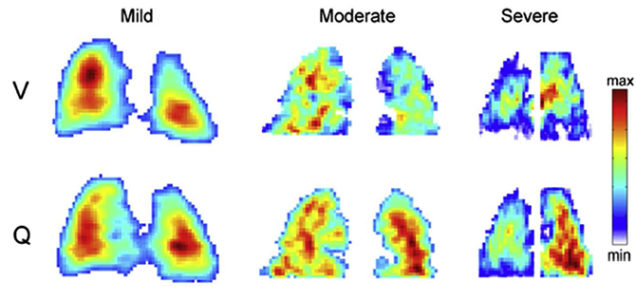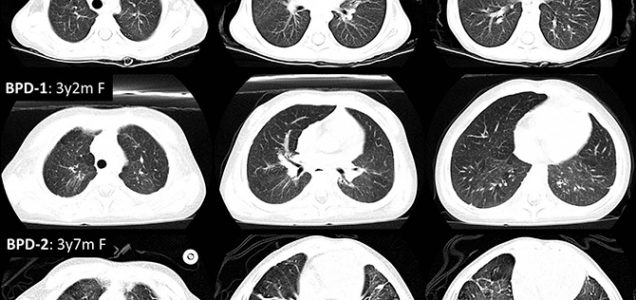
Some babies who are born prematurely require long durations of respiratory support due to underdeveloped lungs and are given a clinical diagnosis of bronchopulmonary dysplasia (BPD). Over the past 20 years, research has fueled improvement in the clinical care and outcomes for the most premature infants, and in parallel, clinical imaging techniques such as chest x-ray and x-ray computed tomography (CT) have been implemented to understand the lung structural pathology associated with preterm birth and BPD.
 Image: The typical appearance of BPD in CT with abnormalities including bronchiectasis, linear and triangular subpleural opaciies, mosaic attenuation and alveolar simplication is demonstrated in BPD-1.
Image: The typical appearance of BPD in CT with abnormalities including bronchiectasis, linear and triangular subpleural opaciies, mosaic attenuation and alveolar simplication is demonstrated in BPD-1.
 Image: BPD-1 close-up.
Image: BPD-1 close-up.
In this review article, we look at how newer clinical imaging techniques will play a role in understanding BPD pathology and how that may impact patient care in the future. One area of growing interest is magnetic resonance imaging (MRI); unlike CT, MRI does not use ionizing radiation to generate images, and thus, can be used repeatedly over time to study how the lungs of BPD patients grow and develop.
Cincinnati Children’s is the only institution in the nation to have an MRI scanner located within the neonatal intensive care unit (NICU), and the Center for Pulmonary Imaging Research (CPIR) has used this scanner and novel techniques to image the lungs of over 70 NICU patients to understand BPD and other lung conditions.
Another area of interest is hyperpolarized noble gas MRI where the scanner takes images of an inhaled gas (helium or xenon) to visualize ventilation. This technique has been used in older subjects with lung diseases such as cystic fibrosis and asthma, and currently at Cincinnati Children’s, there is research to bring this technique to the NICU. This combined expertise in neonatal MRI and hyperpolarized gas puts Cincinnati Children’s on the cutting edge of bringing new imaging research to our BPD patients to improve clinical care and outcomes.
Newer Imaging Techniques for Bronchopulmonary Dysplasia
Laura L. Walkup, PhD and Jason C. Woods, PhD
Read the full research article (click here).
Contributions by Nara Higano (Graduate Student , IRC) and edited by Glenn Miñano, BFA.